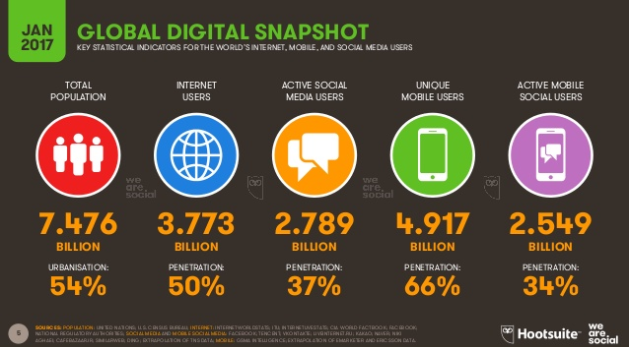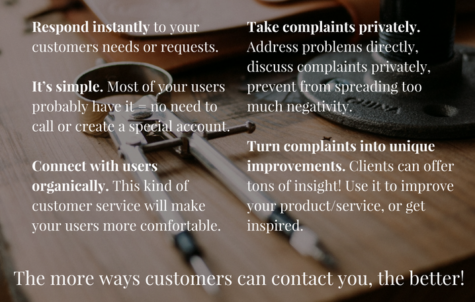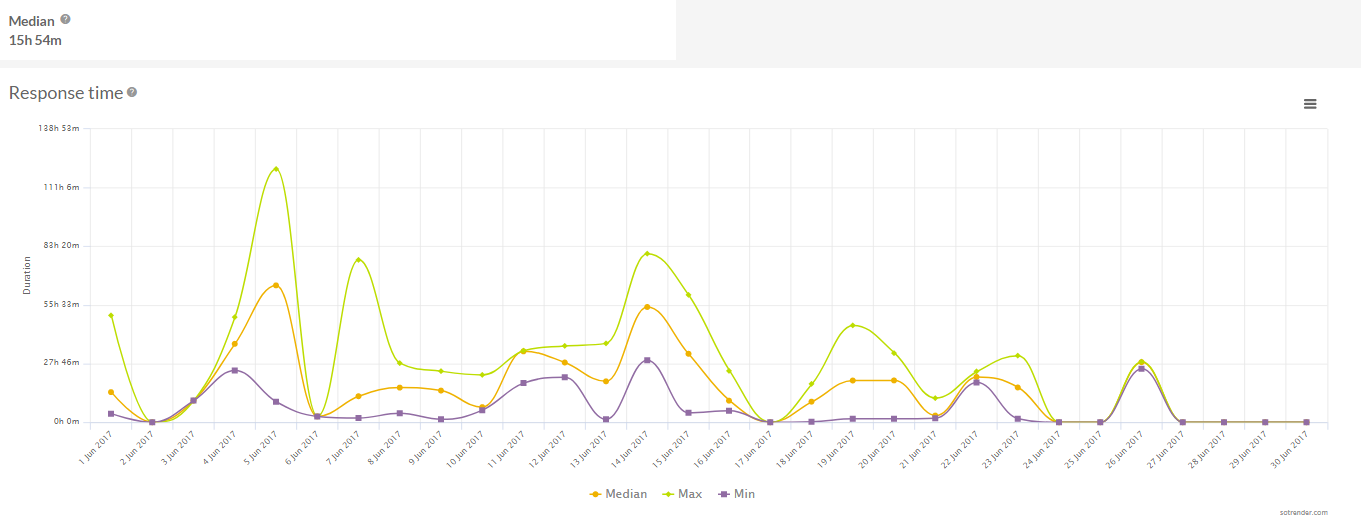The digital world has never been as powerful as it is today. That means that being invisible on the internet is pretty troublesome for brands, since much of your audience will be trying to find you there. But what can be just as bad is having a bad reputation online.
Since numbers speak louder than words, let’s take a look at those first. And the numbers quickly show us that over 50% of the total global population is using the internet. Impressive?

Digital in 2017 – Global Overview / we are social
On the Internet, sharing opinions and reaching more people is easier than it is offline. When it comes to people buying a product from brands and businesses, a majority of people look for other user opinions online. Since your company probably has quite a few competitors on the market, sometimes it’s the little details that determine if a potential client choses your company or your competitors’. In this case, even a lower price sometimes won’t be enough. More and more often people are taking these factors into consideration, like how easy it is to reach you, are other customers satisfied with your product/service, is your website easy to navigate and find relevant information, and many other elements.
84% of people trust online reviews as much as a personal recommendation.
Local Consumer Review Survey carried out by BrightLocal
Your online reputation really does matter. If you want proof, keep in mind that new management branches were established a few years ago. They’re called Online Reputation Management (ORM) and Search Engine Reputation Management (SERM). ORM is basically about monitoring your reputation in the digital world; what people say, feel, and publish about your brand and how to improve based on the feedback they give.
Once you realize that taking care of your online reputation is a must, you need to know what that consists of. And that’s what we’re here to show you.
User Experience
Let’s start with a general and broad issue when it comes to online reputation: the User Experience (UX). Simply saying UX refers to many different aspects of a person’s attitude and feelings towards a product/ service/ etc.

User Experience (UX) – graph
When it comes to your online reputation, UX consists of few important elements.
Your website
For the majority of companies, a website is the main way they present themselves online. But just having it is not enough. These days, everyone is in a rush and for tons of reasons we all want to receive information quickly. That’s why we so often use mobile devices, like smartphones or tablets. So if a potential customer is waiting too long for your page to load or can’t scroll through your website on mobile, you’re likely to lose them. That’s why you need to have a responsive website that works well on various devices.
Don’t forget about improving your website (e.g. readability or loading speed) and other elements like:
- navigation (including visible call-to-action buttons),
- displaying images,
- appropriate font.
There are some easy-to-use tools to check if your website is well optimized (e.g. www.testmysite.withgoogle.com, which tests mobile speed). Also think about what your clients will be looking for – prices, contact, description of your service/ product – and how easily they can find it.
If you can’t afford these changes and it remains user-unfriendly, think about resigning entirely from your current website. It’s becoming quite common for companies to only use social media channels (mainly Facebook) to maintain their online presence (e.g. restaurants or shops). Although this solution has some drawbacks (you’re not the actual owner of a Facebook Page and it can be deleted by Facebook for a number of reasons), it’s a worthwhile idea that you can try out.
High quality
Another thing, also connected to UX, is the level of quality. Everything you create, present, and publish online should be, or even has to be, in high quality. This means both your images and videos, as well as any other form of content – social media posts, blogposts, graphs, and others. Just consider this example – food pictures posted by restaurateurs on Facebook or Instagram can be a real nightmare. They often look really messy and not all that tasty. How are these pics supposed to encourage anyone to visit their restaurant? We’re sure you know what we’re talking about…

P.S. We don’t wanna torture you with a bad example, so here’s a pretty good one. Feel hungry yet?
Visual identity cohesion
Your online presence needs to be consistent. The visual identity of your brand is important not only to look professional, trustworthy, and reliable, but also to establish your brand awareness. It may seem obvious, but believe us when we say that isn’t always the case. It doesn’t look good if your clients sees a different logo, main theme, or colour palette across all of your online channels, does it? Check every portal your company is on and make sure you’re being consistent. It’s usually easy to fix and improve; sometimes you just forgot to update one of your social media channels or a subpage.
That’s all when it comes to what clients see. Now let’s take a look at what they feel, read, and communicate about your brand.
Online reviews
91% of consumers regularly or occasionally read online reviews.
Local Consumer Review Survey carried out by BrightLocal
We bet that you don’t want to lose customers even before you’ve gained them, just because they’ve seen an unfavorable opinion somewhere. People tend to exaggerate, especially when they’re dissatisfied, and often with something not even related to the product itself. But bad reviews remain. Remember that customers always look for the opinion of others, whether on Facebook (not only on your Page), forums, Google+ reviews, evaluation sections under products on e-commerce sites, etc.
You probably know where all these opinions online can be found regarding your own brand. Just remember to keep track of them and stay up-to-date (consider designating one person from your company to be responsible for that). You can also consider asking your clients for reviews right after purchasing and reward them somehow, e.g. offering a discount code for their next purchase.
And then there’re Digital Software Review Platforms (like G2Crowd, Capterra, SaaSGenius etc.). The reviews here are more professional and complex, so using such platforms won’t be equally important and beneficial for every brand or service. They’re highly recommended for SaaS brands or marketing agencies. Note that almost all of them are free to use.
Feel free to take a look at our video, which is based on Sotrender’s G2Crowd reviews.
Keep in mind that good opinions can also attract people to your company, spark their interest, and increase your traffic.
Criticism and negativity
Speaking of reviews, comments, and feedback, let’s gently move to the negative ones. We’re sure you’re aware that you don’t always receive positive feedback.
No matter what, you have to learn how to deal with criticism and negativity.
Firstly, don’t be afraid of negative comments and feedback, especially when they’re constructive. It’s impossible to avoid them, especially in the digital world, where sharing your opinion and being negative is much easier than in the offline world. Think about it rather in terms of improving your product or service and turning complaints into improvements.
If the complaint is public, respond in public as well. That lets everyone know that you’re listening and reacting. But discuss the situation privately with the unsatisfied client, which avoids spreading even more negativity. Then try to satisfy or reimburse them somehow. This will help maintain their loyalty, making sure they’ll come back in the future.
It also doesn’t matter who was responsible for the negative situation that happened. It doesn’t matter if it was you, your employee, or your provider. And sometimes the customer isn’t right. But you just always have to deal with the situation.

Facebook Trends June 2017 – Banks | Customer service
It’s especially important (and also challenging) for telecoms and banking companies to react quickly to customers’ needs and requests – no matter what the situation is. UK banks mentioned above are doing quite well when it comes to customer service. Full ranking on banks in UK can be found in Facebook Trends report.
Consider also providing your customer service employees with the knowledge on how to react and behave in these situations. There are many predictable scenarios, so think about preparing some kind of handbook or conversation guideline. This will not only help your employees and increase their effectiveness, but also ensure consistent customer service. Such a handbook/guideline could include, for example, some standard replies like: Thank you for inquiring about …. A team member will contact you tomorrow with a detailed explanation of a product that fits your business needs/ situation/ etc.
Customer Service
52% of US customers have switched providers in the past year (2016) due to poor customer service.
Accenture’s report
Customer service is strongly connected to the point above and we even touched on it a bit. But customer service is more than just coping with negative feedback. There’s a lot more you have to bear in mind:
- Response-rate and response-time.
- Being helpful and actually responding to client needs and requests.
- Being polite, patient, and positive.
- Knowledge about the product/service your company offers.
To provide successful customer service on social media, keep these in mind:

Read more about customer service on social media.
If you need to keep an eye on your customer service and improve its performance, Sotrender’s got it covered. Just check and analyze, for example, response time.

Response time – chart from Sotrender’s tool
Analyze your social media performance
Keep in mind the active contact you have with your clients and followers. But it’s more about the overall impression and mainly on social media channels. You won’t appear reliable when there are many unanswered comments or questions under your social media posts. At the same time, it’s a good way not only to engage your followers but also to build your brand awareness and customer loyalty.
Your employees
Last but not least, don’t forget about your employees. They are the best brand advocates you could possibly have! Treat them well, appreciate their daily efforts, and they’ll spread the good word about your company without you even having to ask about it.
The first thing that comes to mind is LinkedIn, which is mainly about your professional life and happens to be very useful when either recruiting or looking for a job. But other social media channels can also be helpful (lately that means Facebook, as it can reach huge audiences).
Apart from LinkedIn, there are also other online platforms or websites. For example, Glassdoor, where one can check others opinions and reviews about each employer. They often provide valuable insights about each company and may even frighten potential employees from your company.
Remember that:
- Satisfied employers are a real treasure that can positively benefit your company.
- There must be a reason why your employees spontaneously share company posts regarding news, achievements, or available job positions.
- Spreading bad opinions online is as easy as spreading a good one, there just has to be a reason to do so.
How to monitor your brand’s online reputation?
Take a moment to look at your online reputation. Once you start taking care of it, you should definitely compare and measure if the implemented changes were actually worth it.
Apart from being up-to-date with your online channels (comments on your blog/e-commerce, Google+ reviews, Facebook opinions, private messages, etc.), you can try using some external tools.
Media monitoring tools, e.g.:
- Google Alerts – free
- Brand24
- Sentione
Social media monitoring tools, e.g.: Social Mention, Talkwalker (both free)
ORM Tools, e.g.: ReviewTrackers, ReviewPush
To conclude…
Being present on the internet isn’t the only thing that’s important. You also have to present your brand and product in the best way possible, and it should make you proud.
Implementing all the points mentioned above at once might be difficult, especially if there’s a lot to change and improve. But doing it step by step will be both doable and beneficial.
And don’t ever follow the saying It doesn’t matter what they say (or write) as long as they are talking (writing) about you…








